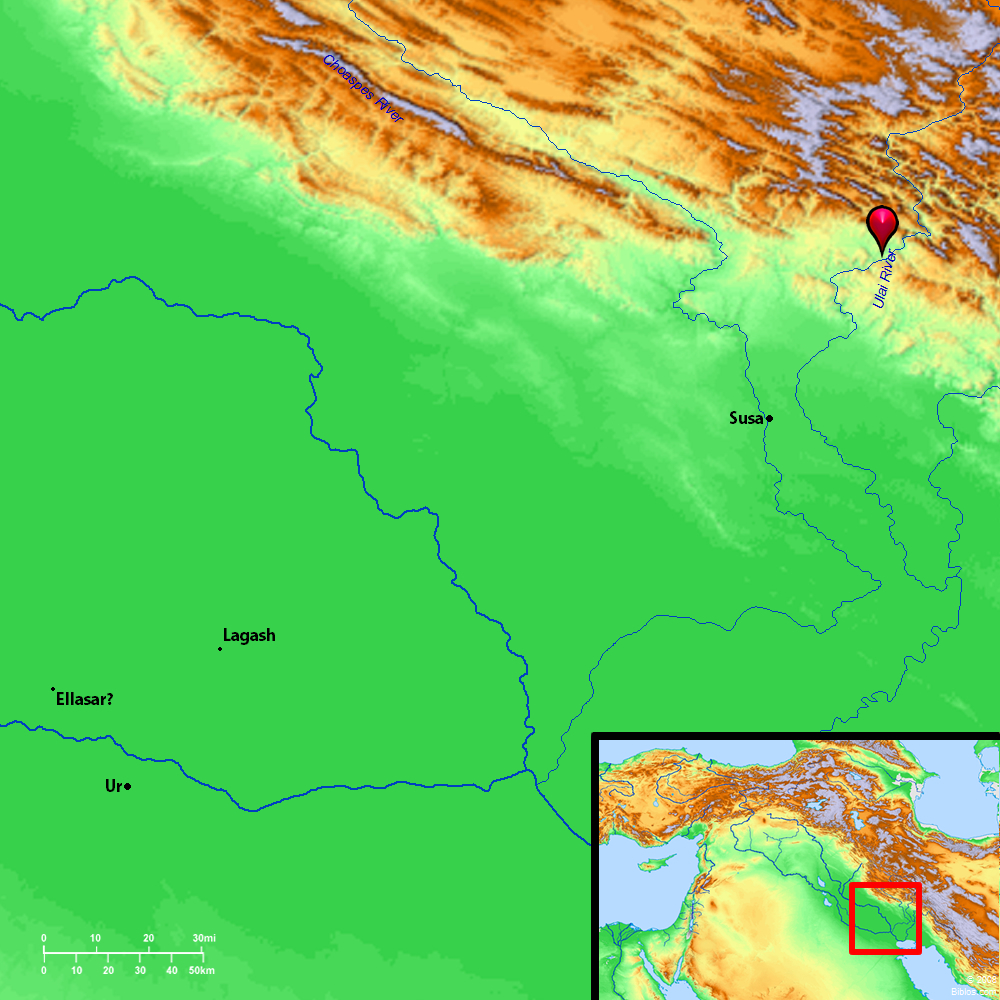Atlas

Ulai (Ulai River) and surrounding region
Maps Created using Biblemapper 3.0Additional data from OpenBible.infoOccurrences
Daniel 8:2 I saw in the vision; now it was so, that when I saw, I was in the citadel of Susa, which is in the province of Elam; and I saw in the vision, and I was by the river Ulai.
Daniel 8:16 I heard a man's voice between the banks of the Ulai, which called, and said, Gabriel, make this man to understand the vision.
Encyclopedia
ULAIu'-li, u'-lai ('ubhal 'ulay, "river Ulai"; Theodotion Daniel 8:2, Oubal, the Septuagint and Theodotion in 8:16, Oulai Latin, Eulaeus):
1. The Name and Its Forms:
A river which, running through the province of Elam, flowed through Shushan or Susa. It was from "between" this river that Daniel (8:16) heard a voice, coming apparently from the waters which flowed between its two banks.
2. Present Names and Course:
Notwithstanding that the rivers of Elam have often changed their courses, there is but little doubt that the Ulai is the Kerkhah, which, rising in the Persian plain near Nehavend (there called the Gamas-ab), is even there a great river. Turned by the mountains, it runs Northwest as far as Bisutun, receiving all the waters of Southern Kurdistan, where, as the Sein Merre, it passes through the inaccessible defiles of Luristan, its course before reaching the Kebir-Kuh being a succession of rapids. Turned aside by this mountain, it follows for about 95 miles the depression which here exists as far as the foothills of Luristan, reaching the Susian plain as a torrent; but it becomes less rapid before losing itself in the marshes of Hawizeh. The course of the stream is said to be still doubtful in places.
3. Changed Bed at Susa:
In ancient times it flowed at the foot of the citadel of Susa, but its bed is now about 1 1/4 miles to the West. The date of this change of course (during which a portion of the ruins of Susa was carried away) is uncertain, but it must have been later than the time of Alexander the Great. The stream's greatest volume follows the melting of the snows in the mountains, and floods ensue if this coincides with the advent of heavy rain. Most to be dreaded are the rare occasions when it unites with the Ab-e-Diz.
4. Assyrian References:
The Ulai (Assyrian Ulaa or Ulaia) near Susa is regarded as being shown on the sculptures of the Assyrian king Ashur-bani-pal (British Museum, Nineveh Gal.) illustrating his campaign against Te-umman. Its rapid stream bears away the bodies of men and horses, with chariots, bows and quivers. The bodies which were thrown into the stream hindered its course, and dyed its waters with their blood.
LITERATURE
See Delegation en Perse: Memoires, I, Recherches Archeologiques, 25;.
T. G. Pinches
ULA'I, a large stream near Susa, called by the Greeks Eulseus. About 20 ms. above Susa it divides and the eastern branch is most probably the Ulai of Dan. 8:2, 16, see map No. 2.
Strong's Hebrew
H195: Ulaya river of Elam




